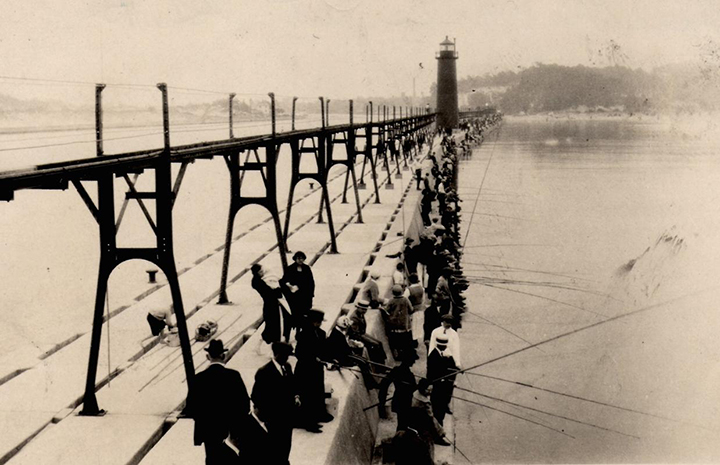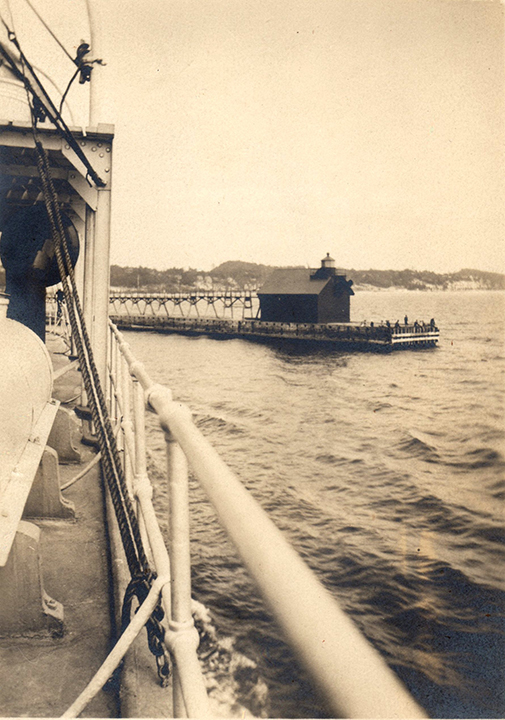
Photo Credit: Tri-Cities Historical Museum
The History of Grand Haven Lighthouse & Pier
Grand Haven-In The Path of Destiny
by David H Seibold, D.D.S.
The Port of Grand Haven had its first lighthouse in 1839, which was built on the beach were today’s Oval is located. It consisted of a five-room cottage for the keeper with a separate light tower. Within a few years the error of the location became apparent and a seawall was built to protect the light tower. Erosion continued and in 1852 a late fall storm took out the seawall on December 6. The storms persisted and, although ice banks slowed the process, less than two weeks later, on December 17, 1852, the tower and cottage collapsed. The Port of Grand Haven was without a beacon for the next three years.
A second light with an adjoining keeper’s dwelling was built in 1855 on the bluff behind and 150 feet above the beach. It was equipped with a $4,000 lenticular French Fresnel lens that reflected light visible for 25 miles under clear conditions. On May 10, 1856 a rotating light was installed which was regulated by a clock work that produced a flash every 1.5 minutes. Seaman were guided by the reassuring beacon for the next 50 years.
When the South Pier was completed to its present length in 1893 it was equipped with a pier-head light. However, the Bluff Light remained the main port beacon until 1905. In the fall of 1904 a 52-foot steel tower was placed on the end of the South Pier and on January 12, 1905 the Fresnel lens was moved from the bluff to the new tower. Everyone, it seemed, knew of the switch except the ship captains, who had not been notified. When the Crosby and Goodrich steamers came into port that night the captains were totally confused and would have grounded had then not been familiar with the port. When the boats docked the air was blue as the captains voiced their opinions about eh debacle.
In 1907 the South Pier tower and light was moved 600 feet back from the end of the pier to its present location.
In 1910 the Bluff Light’s brick tower was torn down and replaced by a brick addition to the living quarters. It served as a residence for the lighthouse keeper and his family until 1939 when the Light Service became part of the Coast Guard. In 1956, the 13-room structure was converted to apartments and continues as a residence today at 900 Harbor Avenue.
Foghorn

Photo Credit: Tri-Cities Historical Museum
Fog has been the age-old curse of the seaman. Through the years several fog alert devices had been tried at American ports and shoal waters-cannons in the 1700s: hand rung bells; wave activation bells; in 1851 mechanically operated bells; foot operated horns; steam whistles by 1855 and by 1868 sirens had been tested.
In 1895 the fog alert at Grand Haven was a steam siren which blasted in the key of F for 5 seconds at intervals of 35 seconds. The steam was produced by an on-site coal-fired boiler. In 1905 the power was converted to two large kerosene engines that generated compressed air for the siren. Both the lighthouse and the fog signal required on-site manpower. A catwalk built above the pier made it possible to reach both under all weather conditions.
In 1922 the end of the South Pier was rebuilt with a new concrete pier head. The old original foghorn house-built in 1875 and still in use today-was placed on the new pier-head and equipped with a state-of-the-art foghorn. The horn was a diaphone type activated by an electric air pump. On December 7, 1922 the fog horn emitted its first resonant mournful “beeeeeeoooooo” sound which became so familiar to residents for miles around the harbor
